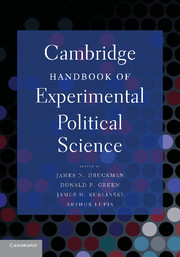Book contents
- Frontmatter
- Contents
- List of Tables
- List of Figures
- Contributors
- Acknowledgments
- INTRODUCTION
- PART I DESIGNING EXPERIMENTS
- PART II THE DEVELOPMENT OF EXPERIMENTS IN POLITICAL SCIENCE
- 6 Laboratory Experiments in Political Science
- 7 Experiments and Game Theory's Value to Political Science
- 8 The Logic and Design of the Survey Experiment
- 9 Field Experiments in Political Science
- PART III DECISION MAKING
- PART IV VOTE CHOICE, CANDIDATE EVALUATIONS, AND TURNOUT
- PART V INTERPERSONAL RELATIONS
- PART VI IDENTITY, ETHNICITY, AND POLITICS
- PART VII INSTITUTIONS AND BEHAVIOR
- PART VIII ELITE BARGAINING
- PART IX ADVANCED EXPERIMENTAL METHODS
- AFTERWORD
- Name Index
- Subject Index
- References
8 - The Logic and Design of the Survey Experiment
An Autobiography of a Methodological Innovation
Published online by Cambridge University Press: 05 June 2012
- Frontmatter
- Contents
- List of Tables
- List of Figures
- Contributors
- Acknowledgments
- INTRODUCTION
- PART I DESIGNING EXPERIMENTS
- PART II THE DEVELOPMENT OF EXPERIMENTS IN POLITICAL SCIENCE
- 6 Laboratory Experiments in Political Science
- 7 Experiments and Game Theory's Value to Political Science
- 8 The Logic and Design of the Survey Experiment
- 9 Field Experiments in Political Science
- PART III DECISION MAKING
- PART IV VOTE CHOICE, CANDIDATE EVALUATIONS, AND TURNOUT
- PART V INTERPERSONAL RELATIONS
- PART VI IDENTITY, ETHNICITY, AND POLITICS
- PART VII INSTITUTIONS AND BEHAVIOR
- PART VIII ELITE BARGAINING
- PART IX ADVANCED EXPERIMENTAL METHODS
- AFTERWORD
- Name Index
- Subject Index
- References
Summary
The title promises a chapter about methods, so a confession is in order. Here, as everywhere, my concerns are substantive, not methodological. Still, what one wants to learn and how one ought to go about learning it are intertwined. So, I propose to bring out the logic of the survey experiment by presenting a classification of survey experiment designs. Specifically, I distinguish three designs: manipulative, permissive, and facilitative. The distinctions among the designs turn on the hypotheses being tested, not the operations performed, and, above all, on the role of predispositions. The first design aims to get people to do what they are not predisposed to do; the second to allow them to do what they are predisposed to do, without encouraging them; and the third to provide them with a relevant reason to do what they already are predisposed to do. Against the background of this threefold classification, I want to comment briefly on some issues of causal inference and external validity and then conclude by offering my own view on the reasons for the explosive growth in survey experiments in the study of public opinion.
The modern survey experiment is the biggest change in survey research in a half century. There is some interest in how it came about, I am told. So I begin by telling how I got the idea of computer-assisted survey experiments.
- Type
- Chapter
- Information
- Cambridge Handbook of Experimental Political Science , pp. 102 - 114Publisher: Cambridge University PressPrint publication year: 2011
References
- 45
- Cited by



